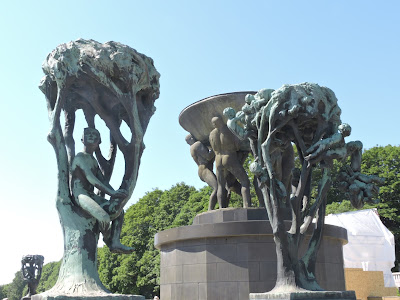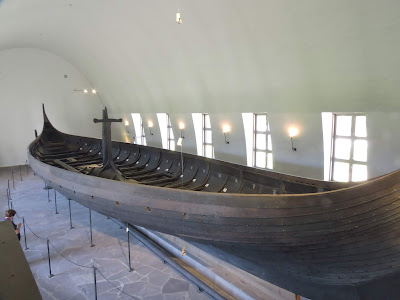 |
Oslo City Hall |
Our tour started at the City Hall which is open to the
public on Sundays. As we approached the 49 bell clarion was playing a song for
the hour. In the court yard are artworks depicting Oak and Elmbla the Norse version of Adam and Eve as well as pictures of Thor and Odin. The Great Hall is where the
Nobel Peace Prize is awarded. Henrik Sorensen's painting “Work, Administration,
and Celebration” is on the back wall. “The Occupation Frieze” on the side wall
depicts the Nazi occupation. The north wall depicts Norwegian occupations. Then
on the west wall is St. Hallverd, Oslo's patron saint.
 |
Vigelund Fountain |
We bused past most of the sites we had walked on Friday,
ending at the Vigelund Sculpture Garden. The garden is dedicated to the human
life cycle with 212 statues in four major works: the bridge, the fountain, the
monolith, and the tree of life. The fountain and monolith are surrounded with
statues that go from youth to old age. The granite monolith dominates the
garden, 17 meters high covered with 121 figures it took three men 13
years to complete the sculptures.
 |
Vigelund Monolith |
Our last stop was the Viking Ship Museum. The Viking era was
from 750 to the 1050 AD. The Vikings needed more farm land and took their ships
both West and East exploring the oceans and rivers for new land. The three
ships in the museum were burial ships. They had been used on the seas but then
were buried in clay with the corpses and the goods they would need in the
afterlife including a intricately carved wagon.The Oseberg ship from 800 AD is
the oldest was buried with two women. It required 30 oarsmen and woolen sails. On the ship were many artifacts, including a large wooden cart. The Gakstad ship is the largest , a replica of this ship sailed the Atlantic
from Norway to America in 1893 to be exhibited in Chicago.
 |
Gakstad Ship |
The last museum was the Fram Museum dedicated to the
explorers of the Polar regions. Ronald Amundsen stands out as a polar explorer: the first to
navigate the Northwest passage, reach the South Pole, and fly to the North
pole. Amundsen's team took 40 months in 1903 to traverse the Northwest passage. They
were helped by the Intuit to make igloos, use sled dogs, ice the runners on
their sledges, use native fur clothing for warmth and learn the foods to eat to
survive in the cold. This was primarily a science expedition, they took
measurements of the magnetic fields discovering that the magnetic poles move.
The Gjøa is the ship they used for the passage and it is preserved in this
museum. They used a petrol engine to supplement their sails, but had to be
careful that the fuel not evaporate away from their tanks.
The Fram was used for his trip to the South Pole, leaving in
1910. Amundsen used all he had learned from the Intuits to be successful on
this trip. He was very exacting on the preparation for this trip including 111
dogs to pull the sleds. He beat Scott to the pole by several weeks, but more
importantly everyone survived. Scott tried to use mechanical vehicles, horses,
dogs, and manpower to move his sleds, many of his team died on the journey. The
Fram was very interesting. He had a wind mill to generate electricity for lights and a piano for entertainment. We could explore most of the ship.

No comments:
Post a Comment